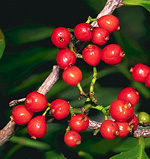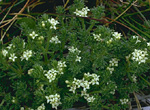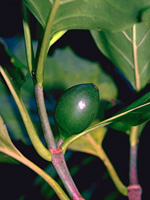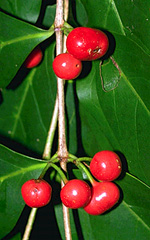 |
This is a large and diverse cosmopolitan family, particularly rich in the tropics but with some temperate and cool-temperate genera as well. In Australia also it is particularly well-represented across northern Australia in rainforests and monsoon forests. A few genera are characteristic of the south-east temperate region and Tasmania, in forests and subalpine and alpine communities. Few species occur in the arid region.
Characteristic features of the family Rubiaceae in Australia include:
- mostly shrubs, some small trees, climbers or scramblers, or herbs,
with opposite or (often) whorled leaves typically with stipules fused
together between the petioles
- flowers regular, usually white or cream and often sweetly scented,
sometimes very small
- sepals 4–5 or numerous, more or less free; petals usually 4-5
but sometimes more or less, usually fused into a long or short tube
- ovary inferior or half-inferior, developing into hard, dry-fleshed
drupes, fleshy berries or capsules, sometimes with several fruitlets
fused into a compound fruit
Description
Evergreen, deciduous or semi-deciduous trees, or shrubs,
or woody or herbaceous vines climbing by hooks or scrambling, or annual,
biennial or perennial terrestrial herbs, or epiphytes. Perennating by
rhizomes or taproots. Vegetative reproduction absent or by rhizomes or
stolons. Stems unarmed or rarely with prickles or spines arising from
the stem surface or the leaf axils; internodes solid or rarely hollow,
terete or distinctly angular. Internal secretions not obvious or rarely
of resin. Plants glabrous, or with simple, glandular or non-glandular,
unicellular, uniseriate or multiseriate hairs. Leaves opposite, or in
whorls of 3–7 or more, cauline if herbs, petiolate, subsessile or sessile,
and with pulvinae present or absent. Stipules apparently absent, or present
and distinct and free from the petiole, ochreate, encircling the petiole
base, intrapetiolar or interpetiolar, scale-like, or membranous, or green
and leafy, or bristle-like, lacerate or fimbriate, falling off early or
persistent. Lamina simple, symmetric, filiform, acicular, subulate, linear,
lanceolate, ovate, elliptic, oblanceolate, oblong or orbicular; margins
entire, or obscurely dentate, or serrate, ±flat, revolute or recurved;
one-veined, or the venation pinnate, with the midrib conspicuous or inconspicuous,
and the venation reticulate or not; surfaces not punctate; herbaceous,
leathery, succulent, rarely membranous or papery. Leaf ligule absent.
Domatia absent, or consisting of pits, pockets or hair tufts in the vein
angles. Male and female flowers occurring on the same plant or on separate
plants, or with all the flowers bisexual, or bisexual flowers occurring
together with either male or female flowers on the same plant. Inflorescences
terminal, axillary, leaf-opposed or rarely intercalary, consisting of
capitula, spikes, panicles, corymbs, thyrses, umbels, dichasial or monochasial
cymes or solitary flowers. Bracts and bracteoles present or absent. Mucilaginous
hairs present or absent on buds. Pollination by insects, small mammals
or wind. Flowers odourless or fragrant, sessile or stalked. Floral disc
present or absent; nectaries absent or present on the disc. Free hypanthium
absent or ±present. Perianth of 2 dissimilar whorls. Calyx regular,
or rarely irregular; segments free or fused, with (1–) 4–5 (–12) sepals
or lobes, valvate or open in bud; calyx cup-shaped, bell-shaped, urn-shaped,
funnel-shaped or tubular, herbaceous or papery, sometimes modified into
a pappus or consisting of bristles or scales; base with spurs, or pouches,
or without appendages. Corolla regular; segments free or fused, with (3–)
4–5 (–9) petals or lobes, alternating with the sepals or calyx lobes,
imbricate or valvate in bud; corolla wheel-shaped, cup-shaped, bell-shaped,
urn-shaped, funnel-shaped, salver-shaped or tubular, white, cream, yellow
or red, or rarely blue, without contrasting markings, or streaked, spotted,
etc, membranous or papery; claws absent; lobes ±entire. Fertile
stamens 3–9, opposite to and alternating with the sepals or calyx lobes,
at least partly fused to the corolla or rarely free, free of the ovary
and style, distinct from each other, all ±equal. Staminal filaments
present or absent. Anthers dorsifixed or basifixed, versatile or not versatile,
opening sideways or inwards by longitudinal slits, 2- or 4-celled; appendages
absent, or apical, or basal. Ovary part-inferior, or inferior. Carpels
(1–) 2 (–8), fused; ovary with 1–2 (–10) locules. Style terminal, single
and unbranched, or branched above, or from the base. Ovules 1–numerous
per locule, sessile; placentation basal, parietal or axile. Fruit derived
from a single flower or from several flowers (composite), dry or fleshy,
dehiscent, or schizocarpic, or indehiscent; a capsule with irregular,
denticidal, septicidal or loculicidal dehiscence, or a schizocarp forming
mericarps (achenarium), or a drupe, or berry-like (sorosus); the perianth
on the maturing fruit deciduous, dry and persistent, or rarely growing
larger. Disseminule macro-surface featureless, winged or with straight
or hooked hairs; micro-surface ±smooth, aculeate, papillate, tuberculate,
reticulate, foveate, granulate, ruminate or rugose, white, cream, yellow,
red, brown, grey or black, glossy or dull. Seeds 1–numerous per fruit.
Aril absent or apparently present. Cotyledons 2. Embryo straight, curved
or sharply bent.
(Note: this description has been generated from the coded data compiled for the key. Any errors in the key data will be reflected in the descriptions.)
A treatment of the family Rubiaceae has not yet been published in the Flora of Australia. It will appear in Volume 36.
Australian genera of Rubiaceae (as recognised for the Flora of Australia)
† = some species native, others introduced
* = all species introduced
Aidia
*Anthocephalus
Antirhea
†Asperula
Bobea
Borreria
Canthium
Coelospermum
*Coffea
†Coprosma
Dentella
*Diodia
Diplospora
Durringtonia
†Galium
Gardenia
†Geophila
Guettarda
Guettardella
Hedyotis
Hodgkinsonia
Hydnophytum
Ixora
Knoxia
Lasianthus
Leptostigma
*Mitracarpus
Morinda
Myrmecodia
Nauclea
Neanotis
Neonauclea
Nertera
Oldenlandia
Opercularia
Ophiorrhiza
Pavetta
Pomax
Psychotria
Psydrax
Randia
*Richardia
Scyphiphora
*Sherardia
*Spermacoce
Synaptantha
Tarenna
Timonius
Uncaria
Wendlandia

|
  |

Aidia cochinchinensis (fruits)
Photo: D.Jones © D.Jones

Asperula pusilla (flowers)
Photo: C.Totterdell © ANBG

Atractocarpus stipularis (fruit)
Photo: D.Jones © D.Jones

Canthium coprosmoides (fruits)
Photo: D.Jones © D.Jones

|
 |
|